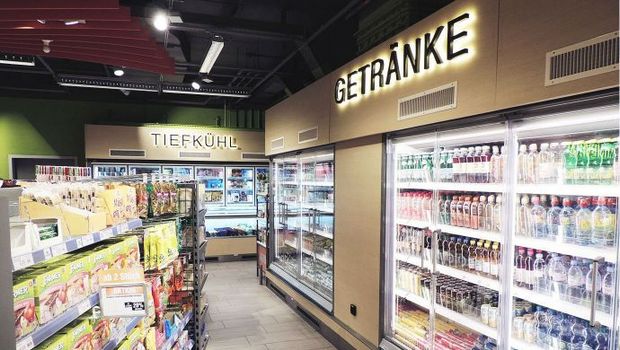Migros testing propane water-loop systems

Keen to trial new technologies as it searches for the most effective means of meeting its sustainability targets, Swiss retailer Migros is installing propane-based water-loop HVAC&R systems in small supermarkets.
Water-loop systems represent an alternative method for businesses such as supermarkets to supply their refrigeration needs in a more flexible, decentralised manner.
Migros currently boasts 25 supermarkets fitted with water-loop systems based on natural refrigerant propane (R290).
Rather than cooling all the supermarket’s cabinets and cold rooms from a centralised refrigeration plant, each wall-mounted display case runs off its own propane system – the latest version of which requires just one circuit per cabinet. The exhaust heat is carried away by a water loop.
For Migros, the business case for choosing a water-loop system is at its most compelling if the store is small enough, if there is limited space on site for a machine room, and if there is demand for hot water elsewhere on the premises.
Accelerate Europe met Andreas Moser, who works on energy efficiency and climate protection in the Migros Engineering Solutions (MES) team, at Migros’s pilot R290 water-loop supermarket in Herdern, a district of Zürich.
“In this store, the water loop rejects the heat to a nearby logistics centre, where it provides hot water for the central heating system,” Moser said.
“Part of the motivation for installing these R290-based water-loop systems is if you don’t have space on site for a machinery room,” said André Deppeler of Cooperative Migros Zürich, who is responsible for the system in the Herdern store.
Competing with CO2
In choosing an HVAC&R system, energy efficiency ranks among the most important decision-making criteria. Despite their other advantages, Migros finds that in central Europe, water-loop systems simply can’t compete with CO2 installations for energy efficiency.
“To be clear, the water-loops are only a potential solution for small supermarkets if no CO2 installation is possible. Energy efficiency is a paramount requirement. Our best CO2 installation still consumes 30% less electricity than our best water-loop system,” Moser said.
Migros monitors all its supermarkets that have been operating for a year or more. The most efficient receive an internal award. In 2017 the average key performance indicator of its top ten supermarkets was 1,600 kWh/m *a per metre of cooling cabinet (including heat recuperation), while its best water loop achieved 2,400 kWh/m *a (without heat recuperation).
kWh/m *a refers to kilowatt hours per metre of cabinet per year, the figure by which Migros measures efficiency.
Asked whether water-loop systems have the potential to become a serious rival to CO2 transcritical, Moser’s colleague Urs Berger – who heads the Energy and Building Technology department at MES, replies: “For most supermarket applications, CO2 will remain the standard. Maybe in the niche market of small convenience stores up to a maximum surface area of around 500 m2, and in train stations and petrol stations, there are possibilities.”
“Water-loop systems are interesting if you don’t have space for machinery to produce the refrigeration centrally,” says Berger. “It depends on the location in which you want to install the system.”
An attractive choice for warmer climates
Berger concedes that in Switzerland’s climate, the efficiency of the R290-based water-loop systems does not compare favourably with CO2 transcritical solutions.
“If you’re designing CO2 transcritical systems for the outside ambient temperatures of Switzerland, then you’re designing for up to 34 °C,” he says. Given that the average annual temperature in Switzerland is 9.5°C, “you’re only operating in that particular scenario for a few hours per year” – meaning that CO2 transcritical remains the more efficient system by far, he admits.
The longer a CO2 system must operate in high ambient temperatures, however, the more attractive a water-loop system becomes as an alternative option. In the warmer climates of southern Europe, Asia or Australia, therefore, the water-loop solution can become more competitive.
Migros will continue to install water-loop systems wherever it isn’t possible to install a CO2 system, for example due to space considerations.
“A large part of our future expansion will be in small convenience stores, and in railway stations, and such like. We’re looking for good, natural refrigerant-based solutions,” Moser says. “This is one of them.”
